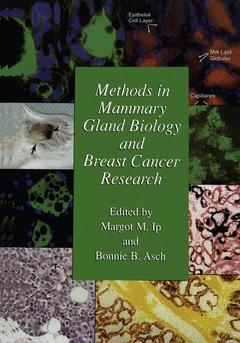Preface. Section 1: In vivo model systems. 1. Mouse models for mammary cancer; D. Medina. 2. Methods for the induction of mammary carcinogenesis in the rat using either 7,12-dimethylbenz(alpha)anthracene or 1-methyl-1-nitrosourea; H.J. Thompson. 3. A comparison of the salient features of mouse, rat and human mammary tumorigenesis; D. Medina, H.J. Thompson. 4. Xenograft models of human breast cancer cell lines and of the MCF10AT model of human preneoplastic, proliferative breast disease; F.R. Miller, G.H. Heppner. 5. Implantation and characterization of human breast carcinomas in SCID mice; Y. Xu, et al. Section 2: Special techniques for in vivo studies. 6. The cleared mammary fat pat and the transplantation of mammary gland morphological structues and cells; L.J.T. Young. 7. Preparing mammary gland whole mounts from mice; S.B. Rasmussen, et al. 8. Slow-release pellets (Elvax) for localized in situ treatments of mouse and rat mammary tissue; G.B. Silberstein, C.W. Daniel. 9. Intramammary delivery of hormones, growth factors and cytokines; B.K. Vonderhaar, E. Ginsburg. 10. Hormonal stimulation of the mouse mammary gland; D. Medina, F. Kittrell. Section 3: In vitro model systems. 11. Collagen gel method for the primary culture of mouse mammary epithelium; W. Imagawa, et al. 12. Chemical carcinogen induced transformation of primary cultures of mouse mammary epithelial cells grown inside collagen gels; R.C. Guzman, et al. 13. Establishment of mouse mammary cell lines; D. Medina, F.Kittrell. 14. Whole organ culture of the mouse mammary gland; E. Ginsburg, B.K. Vonderhaar. 15. Working with the mouse mammary end bud; C.W. Daniel, G.B. Silberstein. 16. Isolation and culture of normal rat mammary epithelial cells; K.M. Darcy, et al. 17. Characterization of normal human breast epithelial cell subpopulations isolated by fluorescence-activated cell sorting and their clonogenic growth in vitro; J. Stingl, et al. 18. Isolation and culture of human breast cancer cells from primary tumors and metastases; S.P. Ethier, et al. Section 4: Molecular analysis and gene transfer techniques. 19. mRNA in situ hybridization in the mammary gland; S. Weber-Hall, T. Dale. 20. Application of in situ PCR to studies of the mammary gland; R.C. Hovey, B.K. Vonderhaar. 21. Transfection of primary mammary epithelial cells by viral and non viral methods; M. Li, et al. 22. Direct gene transfer into the mammary epithelium in situ using retroviral vectors; T.A. Thompson, M.N. Gould. 23. Intraductal injection into the mouse mammary gland; D.-A. Nguyen, et al. 24. Adenoviral and transgenic approaches for the conditional deletion of genes from mammary tissues; K.-U. Wagner, et al. 25. Transplantation and tissue recombination techniques to study mammary gland biology; G.R. Cunha, et al. 26. Rescue of mammary epithelium of early lethal phenotypes by embryonic mammary gland transplantation as exemplified with insulin receptor null mice; G.W. Robinson, et al.




